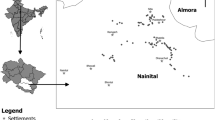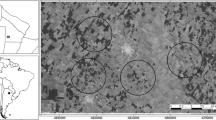Summary
Despite the widespread distribution of the Lesser Spotted Woodpecker, many aspects of the species' biology are poorly known, particularly regarding its habitat requirements in central European forests. Recent studies suggest population declines in many areas of its range, making the need for appropriate management guidelines urgent. In 1997, we examined which habitat factors affect the presence of the Lesser Spotted Woodpecker in decidous lowland, non-riverine forests of northeastern Switzerland and evaluated the usefulness of playback tapes for censusing the species. Selected on the basis of prior knowledge of the species' distribution, 27 forests were searched for Lesser Spotted Woodpeckers using playbacks from March to early May. The species was still present in 17 of these formerly occupied forests, while 5 new registrations were made in previously unoccupied forests. Ninety percent of the registrations occurred between 16 March and 24 April, and the woodpeckers responded to the playbacks most often with call series. The habitat structure of forests with Lesser Spotted Woodpeckers was compared with that of forests where the species had been absent both during previous censuses and in 1997, and which had a similar tree species composition, forest structure and elevation to the occupied forests. Logistic regression analysis identified four habitat variables as significant predictors of the species' presence/absence. Accordingly, forests were most likely occupied by the Lesser Spotted Woodpecker if more softwoods, but fewer snags (with a DBH ≥15 cm) per area were available, if the distance to lakes and rivers was small, and the elevation was low. Therefore, the distribution of the Lesser Spotted Woodpecker seems to be affected by variables reflecting both forest structure and relative position of the forests within the landscape. We conclude that the Lesser Spotted Woodpecker will benefit from protection and promotion of softwood in all forest types, resulting in increased habitat connectivity. Moreover, censuses using playbacks can be efficiently conducted during a short period in March/April.
Zusammenfassung
Viele Aspekte der Autökologie des Kleinspechts(Dendrocopos minor) sind schlecht untersucht. Dies gilt in besonderem Maß für seine Habitatansprüche in den Wäldern Mitteleuropas. Ein Ziel der vorliegenden Arbeit bestand deshalb darin, in ausgewählten Wäldern der Nordost-Schweiz die für den Kleinspecht relevanten Habitatstrukturen zu identifizieren. Ausserdem wurde die Eignung von Tonband-Klangattrappen für die Kartierung untersucht. Für die Habitatanalyse wurden in 21 der 22 Wälder mit Kleinspechten und in einer Kontrollgruppe von 21 Wäldern ohne Kleinspechtvorkommen verschiedene Habitatvariablen erhoben. Mit einer logistischen Regression wurden die Variablen ermittelt, die am meisten zur Unterscheidung der beiden Gruppen beitragen. Es resultierten vier Variablen als Prädiktoren für das Vorkommen von Kleinspechten: 1) Weichhölzer begünstigen die Anwesenheit des Kleinspechts; 2) besiedelte Wälder weisen eine geringere Entfernung zu einem Gewässer auf; 3) Kleinspechte kommen hauptsächlich in tieferen Lagen vor; 4) Die untersuchten Kleinspecht-Wälder weisen im Vergleich mit den Kontrollwäldern weniger stehende tote Bäume mit BHD ≥ 15 cm auf. Die Erhebung von Kleinspecht-Beständen mit einer Klangattrappe kann während eines kurzen Zeitraums im März/April effizient und zuverlässig durchgeführt werden.
Similar content being viewed by others
Literatur
Angelstam, P. & Mikusinski, G. (1994): Woodpecker assemblages in natural and managed boreal and hemiboral forest — a review. Ann. Zool. Fennici 31: 157–172.
Aulén, G. (1988): Ecology and distribution history of the White-backed WoodpeckerDendrocopos leucotos in Sweden. Dissertation, Swedish Univ. Agric. Sci., Uppsala.
Blume, D. & Tiefenbach, J. (1997): Die Buntspechte. Neue Brehm Bücherei 315, Magdeburg.
Flade, M. (1994): Die Brutvogelgemeinschaften Mittel- und Norddeutschlands. Eching.
Glutz von Blotzheim, U. N. & Bauer, K. M. (1980): Handbuch der Vögel Mitteleuropas, Band 9. Wiesbaden.
Grüebler, M. (1997): Arthropodenangebot auf Eichen und dessen Nutzung durch rindenabsuchende Vögel im Winter. Diplomarbeit, Zool. Mus. Univ. Zürich.
Hagvar, S., Hagvar, G. & Monness, E. (1990): Nest site selection in Norwegian woodpeckers. Hol. Ecol. 13: 156–165.
Havelka, P. & Ruge, K. (1993): Trends der Populationsentwicklung bei Spechten (Picidae) in der Bundesrepublik Deutschland. Beih. Veröff. Naturschutz Landschaftspflege Bad.-Württ. 67: 33–38.
Hoentsch, K. (1996): Radiotelemetrische Untersuchungen zur Raum-Zeit-Nutzung des KleinspechtsPicoides minor. Diplomarbeit, TU Darmstadt.
Menard, S. (1995): Applied logistic regression analysis. Iowa.
Mikusinski, G. & Angelstam, P. (1997): European woodpeckers and anthropogenic habitat change: a review. Vogelwelt 118: 277–283.
Müller, W. (1982): Die Besiedlung der Eichenwälder im Kanton Zürich durch den MittelspechtDendrocopos medius. Ornithol. Beob. 79: 105–119.
Olsson, O., Nilsson, I. N., Nilsson, S. G., Pettersson, B., Stagen, A. & Wiktander, U. (1992): Habitat preferences of the Lesser Spotted WoodpeckerDendrocopos minor. Orn. Fenn. 69: 119–125.
Olsson, O. (1998): Through the eyes of a woodpecker: understanding habitat selection, territory quality and reproductive success from individual behaviour. Dissertation, Dept. Ecol., Lund Univ., Schweden.
Pettersson, B. (1993): Breeding habitat of Lesser Spotted Woodpecker (Dendrocopos minor) in South Sweden. Beih. Veröff. Naturschutz Landschaftspflege Bad.-Württ. 67: 127–132.
Roche, J. C. (1995): Die Vogelstimmen Europas auf 4 Cd. Stuttgart.
Schmid, H. (1993): Grün-, Grau- und Kleinspecht (Picus viridis, P. canus, Dendrocopos minor) in der Schweiz: aktuelle Verbreitung und Bestandessituation. Ornithol. Beob. 90: 201–212.
Schmid, H., Luder, R., Naef-Daenzer, B., Graf, R. & Zbinden, N. (1998): Schweizer Brutvogelatlas. Verbreitung der Brutvögel in der Schweiz und im Fürstentum Liechtenstein 1993–1996. Sempach.
Spitznagel, A. (1993): Warum sind Spechte schwierig zu erfassende Arten? Beih. Veröff. Naturschutz, Landschaftspflege Bad.-Württ. 67: 59–70.
Stahel, W. A. (1995): Statistische Datenanalyse; Eine Einführung für Naturwissenschaftler. Braunschweig.
Török, J. (1990): Resource partitioning among three woodpecker speciesDendrocopos spp. during the breeding season. Hol. Ecol. 13: 257–264.
Weggler, M. (1991): Brutvögel im Kanton Zürich. Zürcher Vogelschutz.
Wiktander, U., Nilsson, I. N., Nilsson, S. G., Olsson, O., Pettersson, B. & Stagen, A. (1992): Occurence of the Lesser Spotted WoodpeckerDendrocopos minor in relation to area of deciduous forest. Orn. Fenn. 69: 113–118.
Wiktander, U. (1998): Reproduction and survival in the lesser spotted woodpecker. Dissertation, Dept. Ecol., Lund Univ., Schweden.
Zbinden, N., Glutz von Blotzheim, U. N., Schmid, H. & Schifferli, L. (1994): Liste der Schweizer Brutvögel mit Gefährdungsgrad in den einzelnen Regionen. In: P. Duelli (Hrsg.): Rote Listen der gefährdeten Tierarten der Schweiz: 24–30. Bern.
Author information
Authors and Affiliations
Rights and permissions
About this article
Cite this article
Miranda, B., Pasinelli, G. Habitatansprüche des Kleinspechts(Dendrocopos minor) in Wäldern der Nordost-Schweiz. J Ornithol 142, 295–305 (2001). https://doi.org/10.1007/BF01651368
Accepted:
Published:
Issue Date:
DOI: https://doi.org/10.1007/BF01651368




